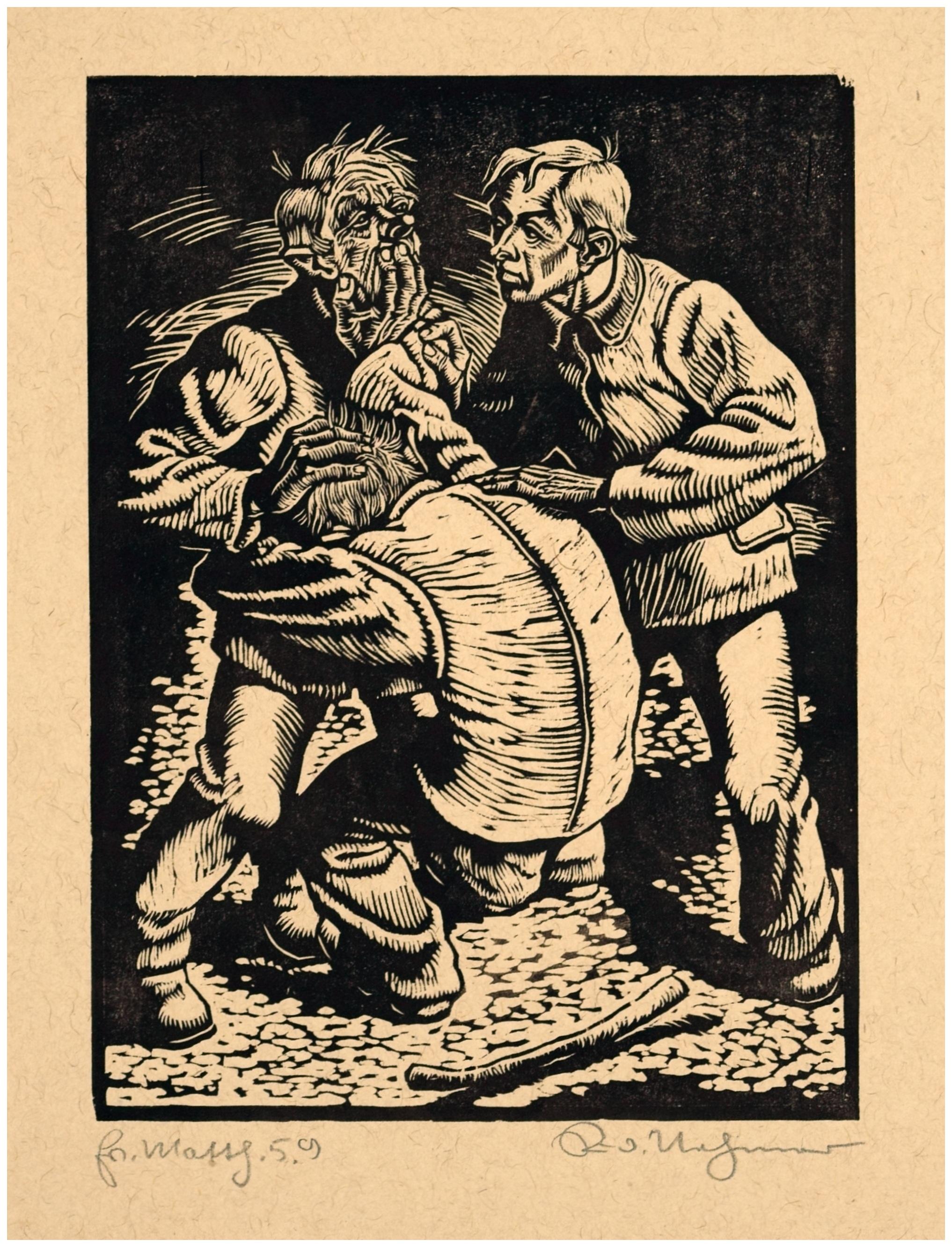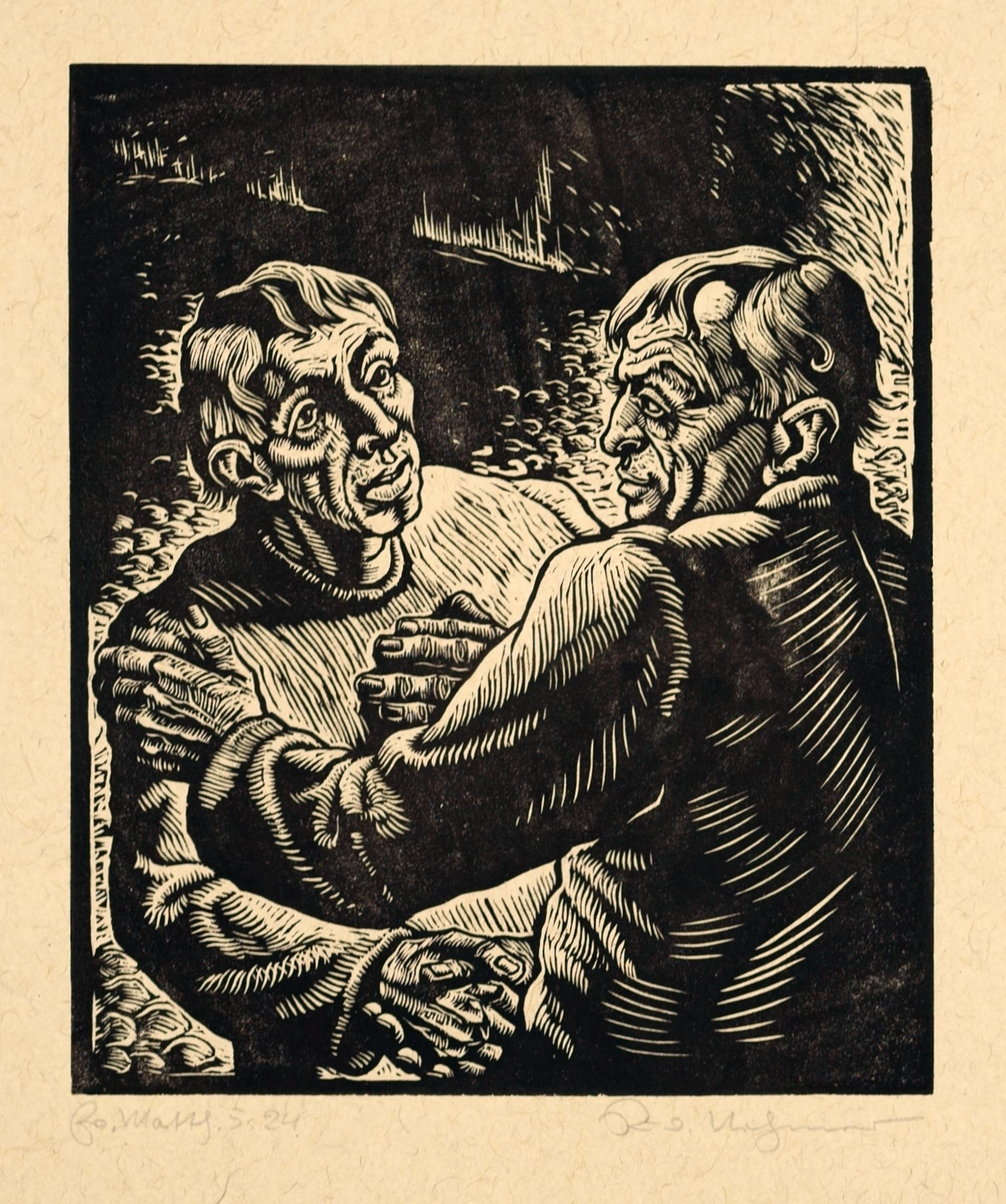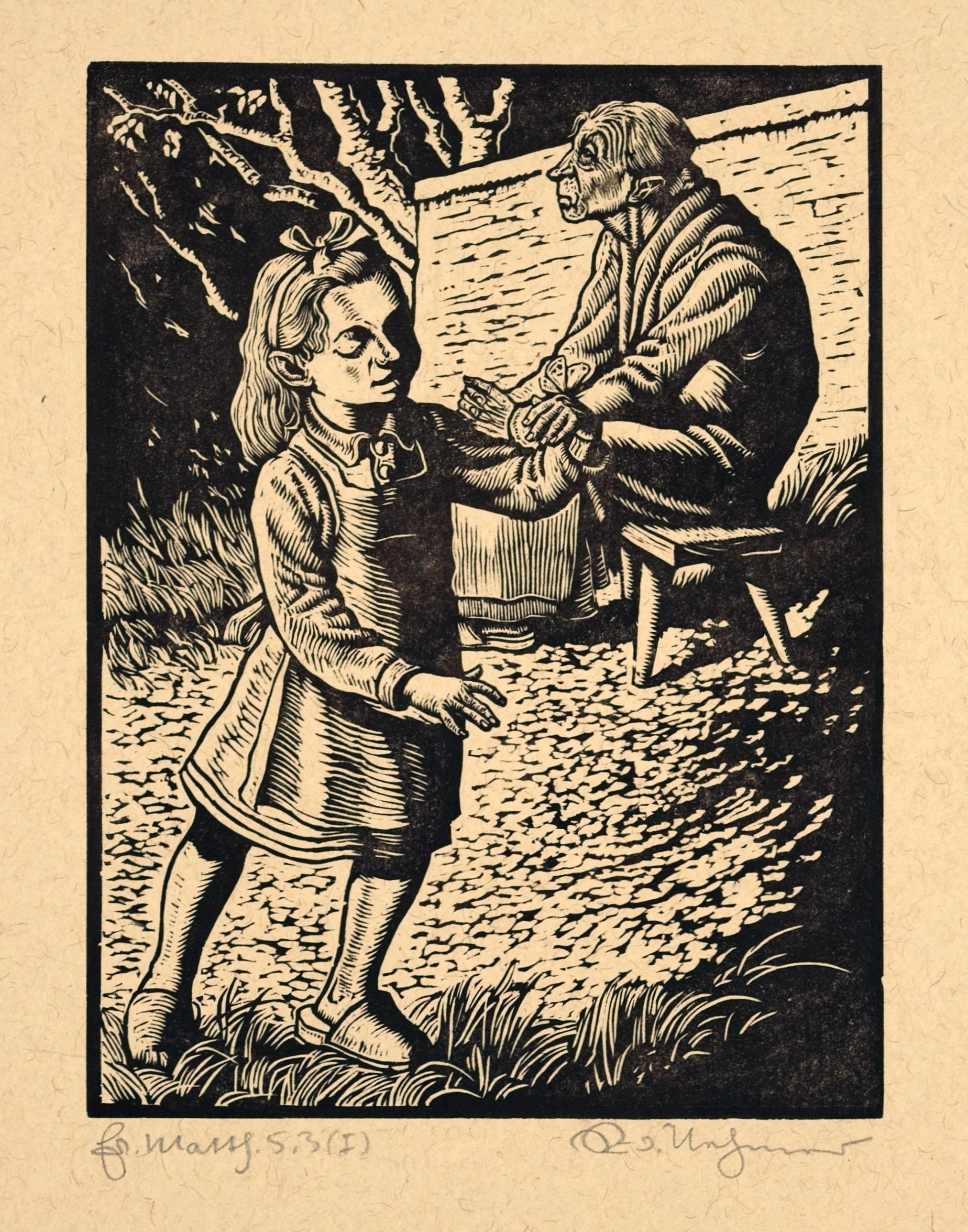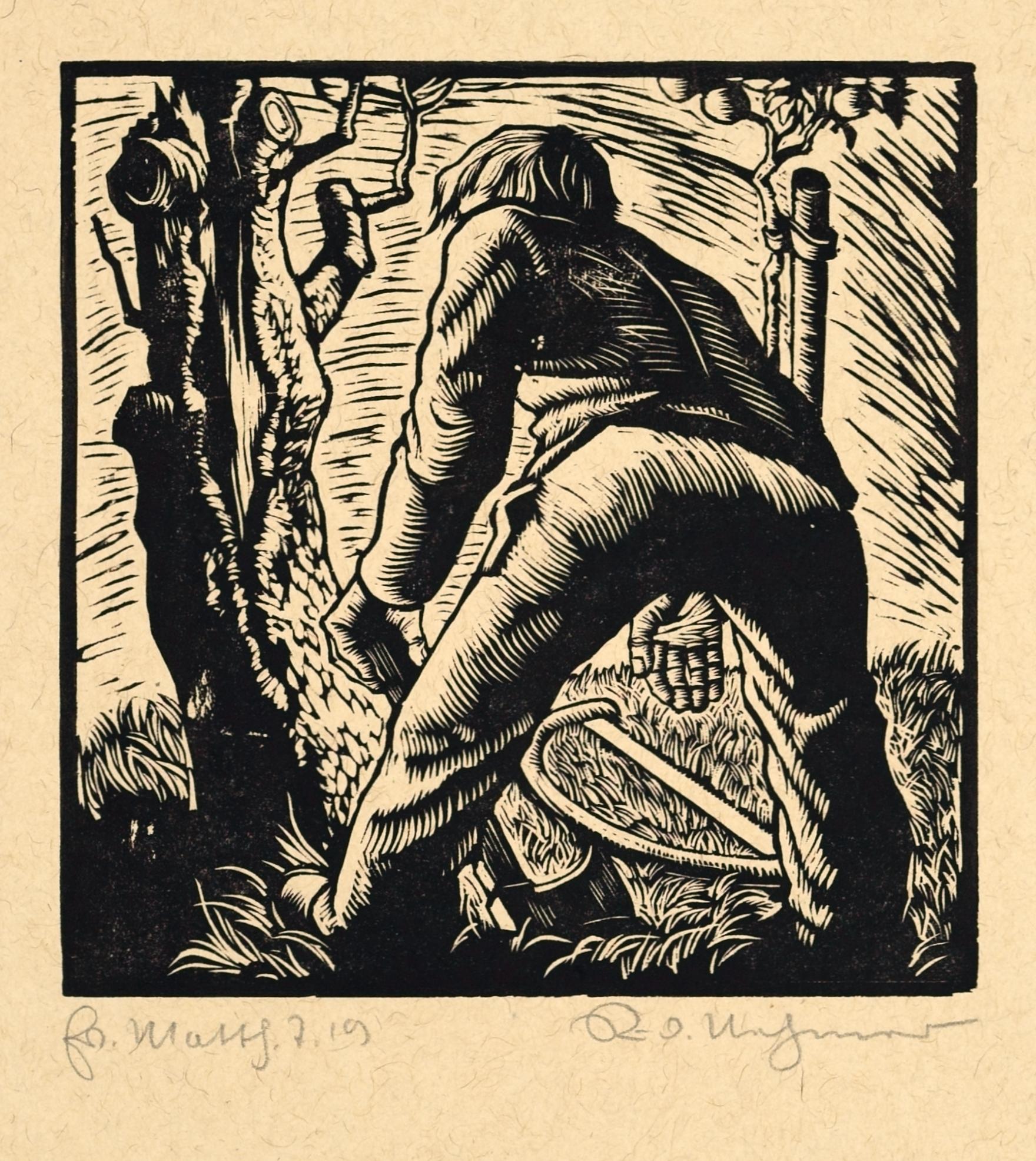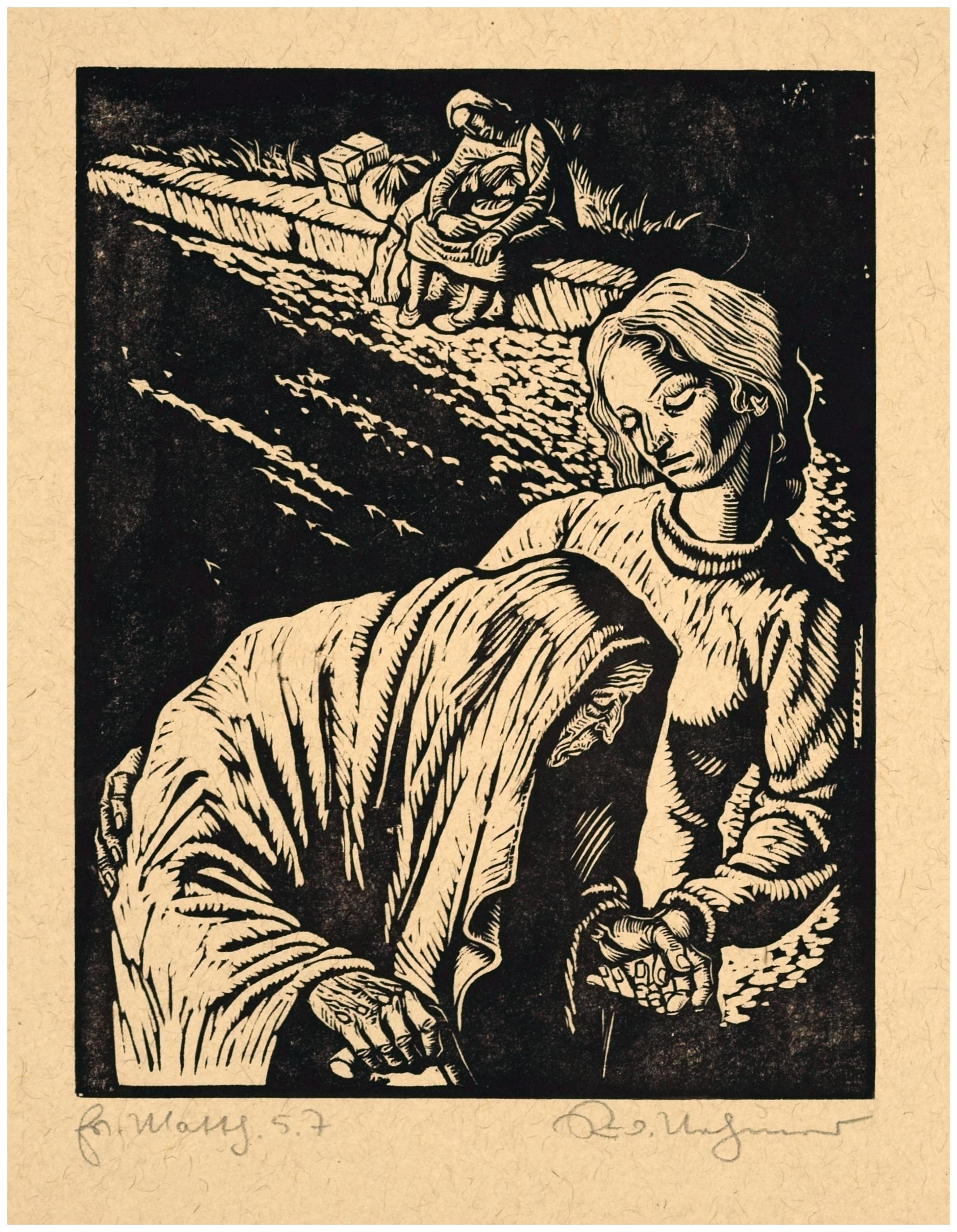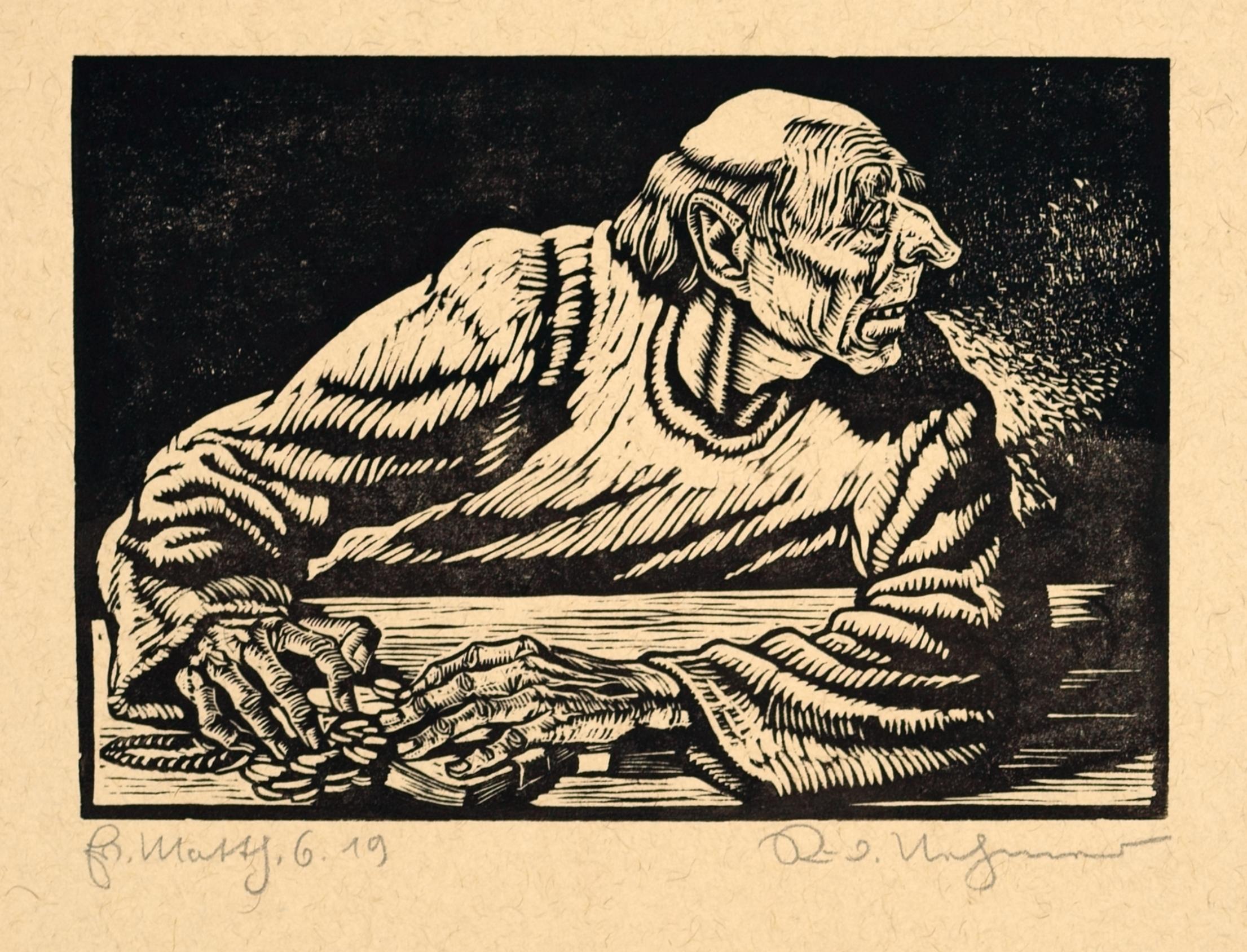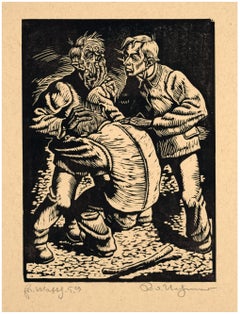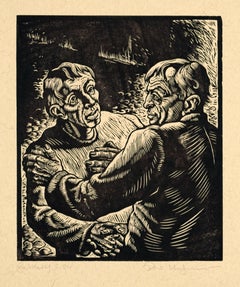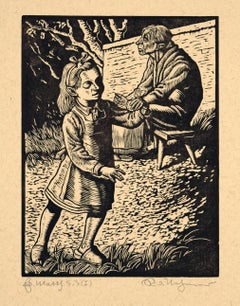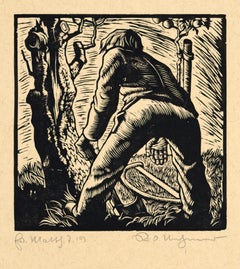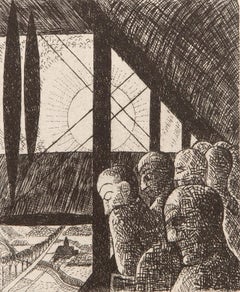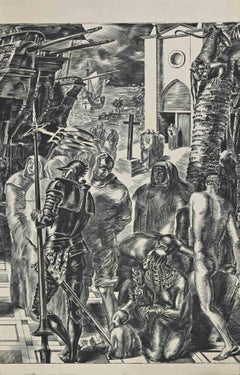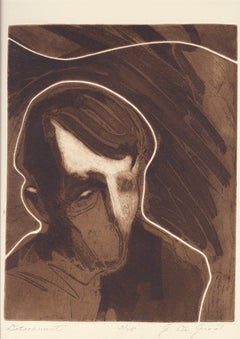Items Similar to The Zero Hour / - After the End of the World -
Want more images or videos?
Request additional images or videos from the seller
1 of 8
Rudolf NehmerThe Zero Hour / - After the End of the World -1948
1948
$329.49
£251.18
€280
CA$465.39
A$508.84
CHF 266.03
MX$6,121.25
NOK 3,366.30
SEK 3,157.30
DKK 2,132.55
About the Item
Rudolf Nehmer (1912 Bobersberg - 1983 Dresden), The Zero Hour, 1948. Woodcut on yellowish wove paper, 20 cm x 14.8 cm (image), 43 cm x 30 cm (sheet size), signed “Rud.[olf] Nehmer” in pencil lower right and inscribed “Matth. 5,4” lower left.
- The wide sheet margin somewhat wavy, the depiction in excellent, colorful condition.
- After the End of the World -
This woodcut is part of Nehmer's best-known series, his pictorial interpretation of the Sermon on the Mount (Matth. 5:1-7:29), created shortly after the end of World War II. The print illustrates the beatitude: Blessed are those who mourn, for they will be comforted (Mt 5:4).
The man seated on the left looks at the viewer with an expression of inner emptiness, while the people around him are sunk in despair and the world lies in ruins. All that remains is ruin and death - an apocalypse that has torn the world apart and yet, as a man-made work, does not cancel out the course of the world as such. The man's gaze formulates the questions addressed to the viewer: what has happened and what have I done?
About the artist
Rudolf Nehmer studied from 1932 to 1934 in Dresden at the private art academy founded by Ernst Oskar Simonson-Castelli under Woldemar Winkler and, after a brief interlude at the art academy, was a student in Willy Kriegel's studio until 1936. After his first one-man show in 1935 at the Kühl Art Exhibition in Dresden, which was progressive until the Nazi era, Nehmer was represented at the major German art exhibitions in the following years. In 1938 he stayed in Worpswede. From 1941 he was a soldier on the Western Front and in Denmark, returning to Dresden from British captivity in 1945. After the war, he had his first solo exhibition in 1945. Nehmer was a co-founder of the artists' association 'Das Ufer - Gruppe 1947' and in 1951 a founding member of the artists' cooperative 'Kunst und Zeit'. He had numerous solo and group exhibitions in the GDR, culminating in a retrospective at the Galerie Neuer Meister on the occasion of his 60th birthday.
GERMAN VERSION
Rudolf Nehmer (1912 Bobersberg - 1983 Dresden), Die Stunde Null, 1948. Holzschnitt auf gelblichem Velin, 20 cm x 14,8 cm (Darstellung), 43 cm x 30 cm (Blattgröße), unten rechts in Blei mit „Rud.[olf] Nehmer“ signiert und unten links mit „Matth. 5,4“ bezeichnet.
- Der breite Blattrand etwas gewellt, die Darstellung in ausgezeichnetem farbkräftigem Zustand.
- Nach dem Weltenbrand -
Der Holzschnitt gehört zu Nehmers bekanntester Graphikfolge, seiner kurz nach dem Ende des Zweiten Weltkrieges geschaffenen bildlichen Auslegung der Bergpredigt (Matth. 5,1-7,29). Das Blatt veranschaulicht die Seligpreisung: Selig sind, die da Leid tragen; denn sie sollen getröstet werden (Matth. 5,4).
Mit einem Ausdruck innerer Leere blickt der links sitzende Mann Richtung Betrachter, während die Menschen um ihn herum in Verzweiflung versunken sind und die Welt in Trümmern daliegt. Nichts ist geblieben als Verderben und Tod – eine Apokalypse, die die Welt aus den Fugen gehoben hat und als menschengemachtes Werk dennoch den Lauf der Welt nicht als solchen aufhebt. Der Blick des Mannes formuliert die an den Betrachter gerichteten Fragen, was ist nur geschehen und was habe ich nur getan?
zum Künstler
Rudolf Nehmer studierte von 1932 bis 1934 in Dresden an der von Ernst Oskar Simonson-Castelli gegründeten privaten Kunstakademie bei Woldemar Winkler und war – nach einem kurzen Intermezzo an der Kunstakademie – bis 1936 Schüler im Atelier von Willy Kriegel. Nach einer ersten Einzelausstellung im Jahre 1935 in der bis in die NS-Zeit hinein progressiven Dresdner Kunstausstellung Kühl, war Nehmer in den Folgejahren in den Großen Deutschen Kunstausstellungen vertreten. 1938 weilte er in Worpswede. Ab 1941 war er Soldat an der Westfront und in Dänemark und kehrte 1945 aus britischer Kriegsgefangenschaft nach Dresden zurück. Nach dem Kriegsende erfolgte bereits 1945 die erste Einzelausstellung. Nehmer war Mitbegründer der Künstlervereinigung ‚Das Ufer – Gruppe 1947‘ und war 1951 Gründungsmitglied der Künstlergenossenschaft ‚Kunst und Zeit‘. In der DDR erfolgten zahlreiche Einzelausstellungen und Ausstellungsbeteiligungen, die in einer Retrospektive anlässlich seines 60. Geburtstags in der Galerie Neuer Meister gipfelte.

About the Seller
5.0
Vetted Professional Seller
Every seller passes strict standards for authenticity and reliability
Established in 2014
1stDibs seller since 2023
22 sales on 1stDibs
- ShippingRetrieving quote...Shipping from: Berlin, Germany
- Return Policy
Authenticity Guarantee
In the unlikely event there’s an issue with an item’s authenticity, contact us within 1 year for a full refund. DetailsMoney-Back Guarantee
If your item is not as described, is damaged in transit, or does not arrive, contact us within 7 days for a full refund. Details24-Hour Cancellation
You have a 24-hour grace period in which to reconsider your purchase, with no questions asked.Vetted Professional Sellers
Our world-class sellers must adhere to strict standards for service and quality, maintaining the integrity of our listings.Price-Match Guarantee
If you find that a seller listed the same item for a lower price elsewhere, we’ll match it.Trusted Global Delivery
Our best-in-class carrier network provides specialized shipping options worldwide, including custom delivery.More From This Seller
View AllBlessed are the peacemakers / - Dehumanization -
Located in Berlin, DE
Rudolf Nehmer (1912 Bobersberg - 1983 Dresden), Blessed are the peacemakers, 1948. Woodcut on yellowish wove paper, 18 cm x 15.5 cm (image), 45 cm x 30 cm (sheet size), signed “Rud.[...
Category
1940s Realist Figurative Prints
Materials
Woodcut
The Reconciliation / - Togetherness -
Located in Berlin, DE
Rudolf Nehmer (1912 Bobersberg - 1983 Dresden), The Reconciliation, 1948. Woodcut on yellowish wove paper, 20 cm x 15 cm (image), 45 cm x 30 cm (sheet size), signed “Rud.[olf] Nehmer...
Category
1940s Realist Figurative Prints
Materials
Woodcut
Blessed are the spiritually poor / - The Abundance of Poverty -
Located in Berlin, DE
Rudolf Nehmer (1912 Bobersberg - 1983 Dresden), Blessed are the spiritually poor, 1948. Woodcut on yellowish wove paper, 20 cm x 15 cm (image), 45 cm x 30 cm (sheet size), signed “Ru...
Category
1940s Realist Figurative Prints
Materials
Woodcut
The fruitless tree / - The End of the Grotesque Era -
Located in Berlin, DE
Rudolf Nehmer (1912 Bobersberg - 1983 Dresden), The fruitless tree, 1948. Woodcut on yellowish wove paper, 15 cm x 14.6 cm (image), 45 cm x 30 cm (sheet size), signed “Rud.[olf] Nehm...
Category
1940s Realist Figurative Prints
Materials
Woodcut
Blessed are the merciful / - The support of care -
Located in Berlin, DE
Nehmer, Rudolf (1912-1983), Blessed are the merciful, 1948
Rudolf Nehmer (1912 Bobersberg - 1983 Dresden), Blessed are the merciful, 1948. Woodcut on yellowish wove paper, 18.8 cm x ...
Category
1940s Realist Figurative Prints
Materials
Woodcut
Greed / - The Poverty of Wealth -
Located in Berlin, DE
Rudolf Nehmer (1912 Bobersberg - 1983 Dresden), The birds under the sky, 1948. Woodcut on yellowish wove paper, 11 cm x 18 cm (depiction), 43 cm x 30 cm (sheet size), signed “Rud.[ol...
Category
1940s Realist Figurative Prints
Materials
Woodcut
You May Also Like
Isaac Friedlander, My People
By Isaac Friedlander
Located in New York, NY
Isaac (sometimes Isac) Friedlander's large wood engraving, My People, 1944, reflects his genuine social interest. After a youth of extreme hardship, including incarceration in a czar...
Category
1940s Expressionist Figurative Prints
Materials
Woodcut
Composition, Vers un monde volage, Marcel Gromaire
By Marcel Gromaire
Located in Southampton, NY
Etching on vélin d'Arches paper. Unsigned and unnumbered, as issued. Good condition. Published by Éditions Marcel Seheur, Paris; printed by Atelier d'art Paul Haasen, Paris, Septembe...
Category
1920s Modern Figurative Prints
Materials
Etching
$1,436 Sale Price
20% Off
Free Shipping
The Departure from The Port - Etching - Early 20th Century
Located in Roma, IT
The Departure from The Port is an original etching realized by an Anonymous artist in the Early 20th Century.
In good conditions with some folding and ...
Category
Early 20th Century Modern Figurative Prints
Materials
Etching
Detatchment
By Georges Hugh De Groat
Located in Middletown, NY
Etching and aquatint printed in brown and black with embossing, 15 x 11 3/4 (381 x 298); sheet 20 1/2 x 16 3/4 inches (521 x 426 mm), full margins. Signed, tited and numbered 3/25 in...
Category
Mid-20th Century Modern Figurative Prints
Materials
Etching, Aquatint
Frank Kleinholz, World Premier
By Frank Kleinholz
Located in New York, NY
Frank Kleinholz was a lawyer-turned-modernist-artist. This work may have been printed in France in the late 1940s when he went there to learn lithography. He returned to the states i...
Category
Mid-20th Century American Modern Figurative Prints
Materials
Lithograph
Towards Exile - Original Lithograph by Pietro Morando - 1950s
By Pietro Morando
Located in Roma, IT
Towards Exile is an original artwork realized by Italian artist Pietro Morando (Alessandria 1889- 1980).
Lithographic print.
Very good condition.
Hand-signed on the lower right in...
Category
1950s Modern Figurative Prints
Materials
Lithograph
More Ways To Browse
Brian Clarke
Bruno Schulz
Caroline Durieux On Sale
Chagall Arabian Nights
Chagall In The Land Of Gods
Chagall Maternity
Chagall Paysage
Chagall Romeo
Chagall Ruth Gleaning
Chagall Signed Poster
Christ And The Rembrandt
Christian Silvain
Clemens Briels On Sale
Collier Picasso
Corneille Bleu
Cristina Martinez
Dali Alice In Wonderland
Dali Aliyah
